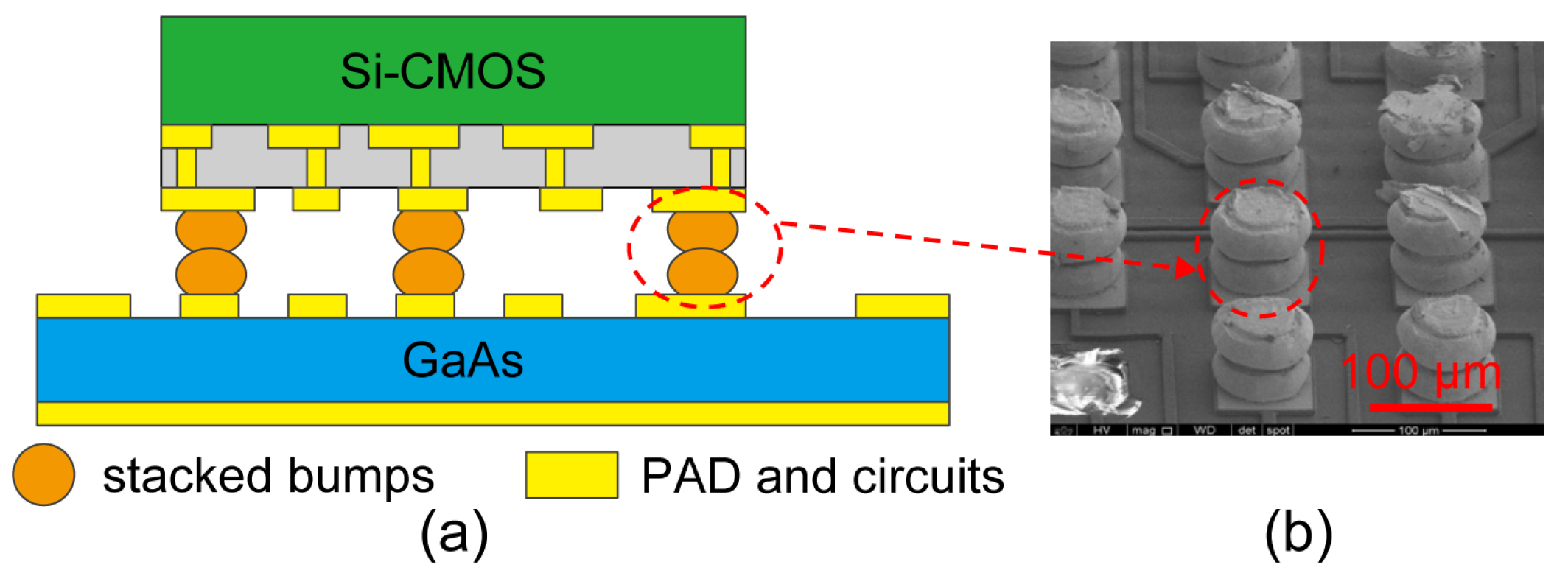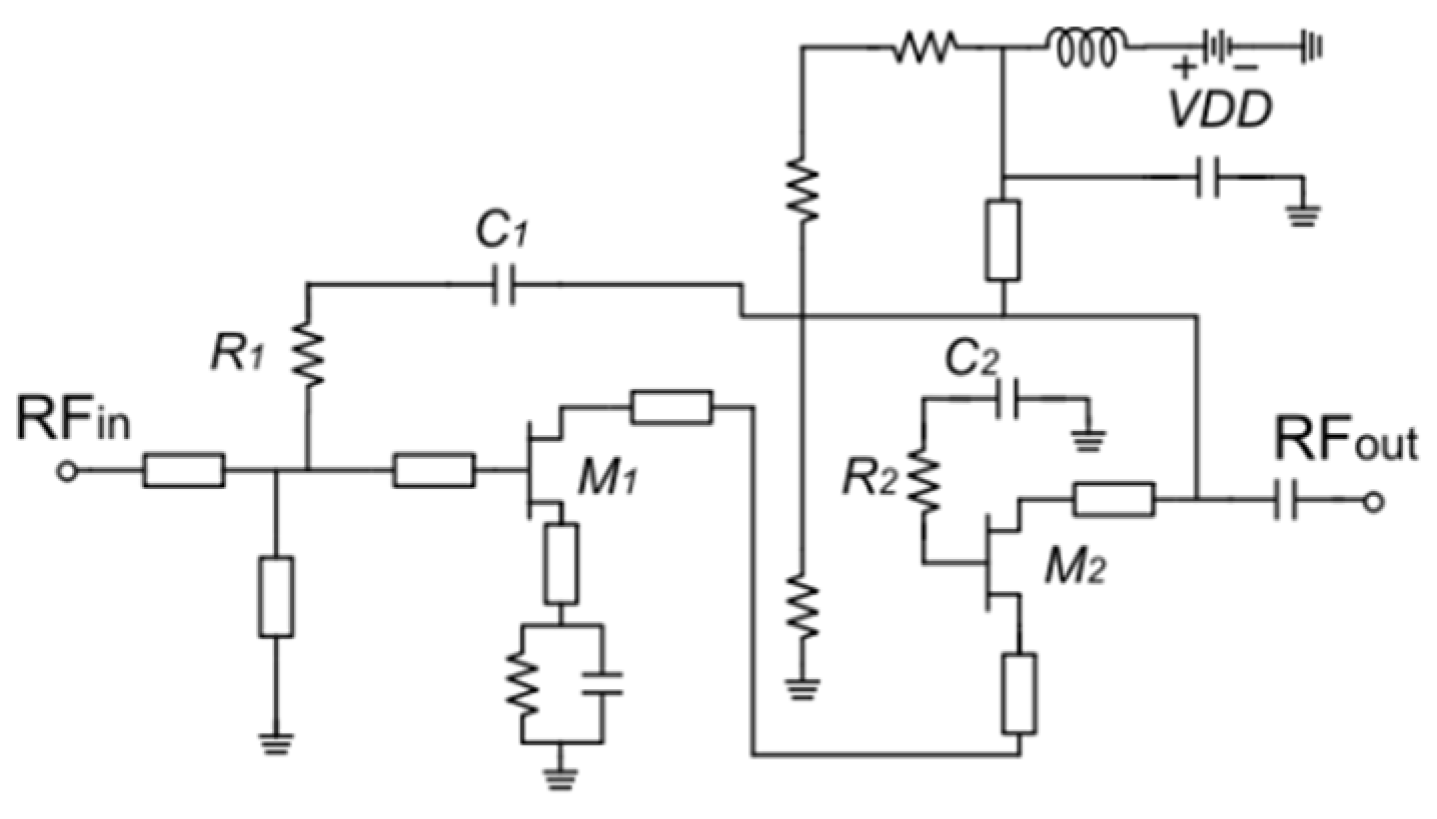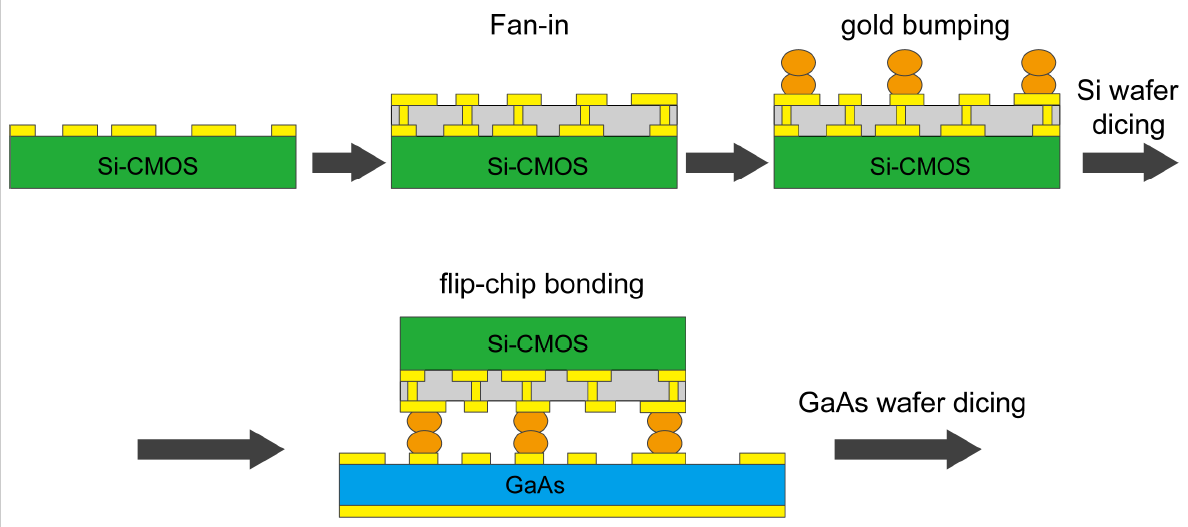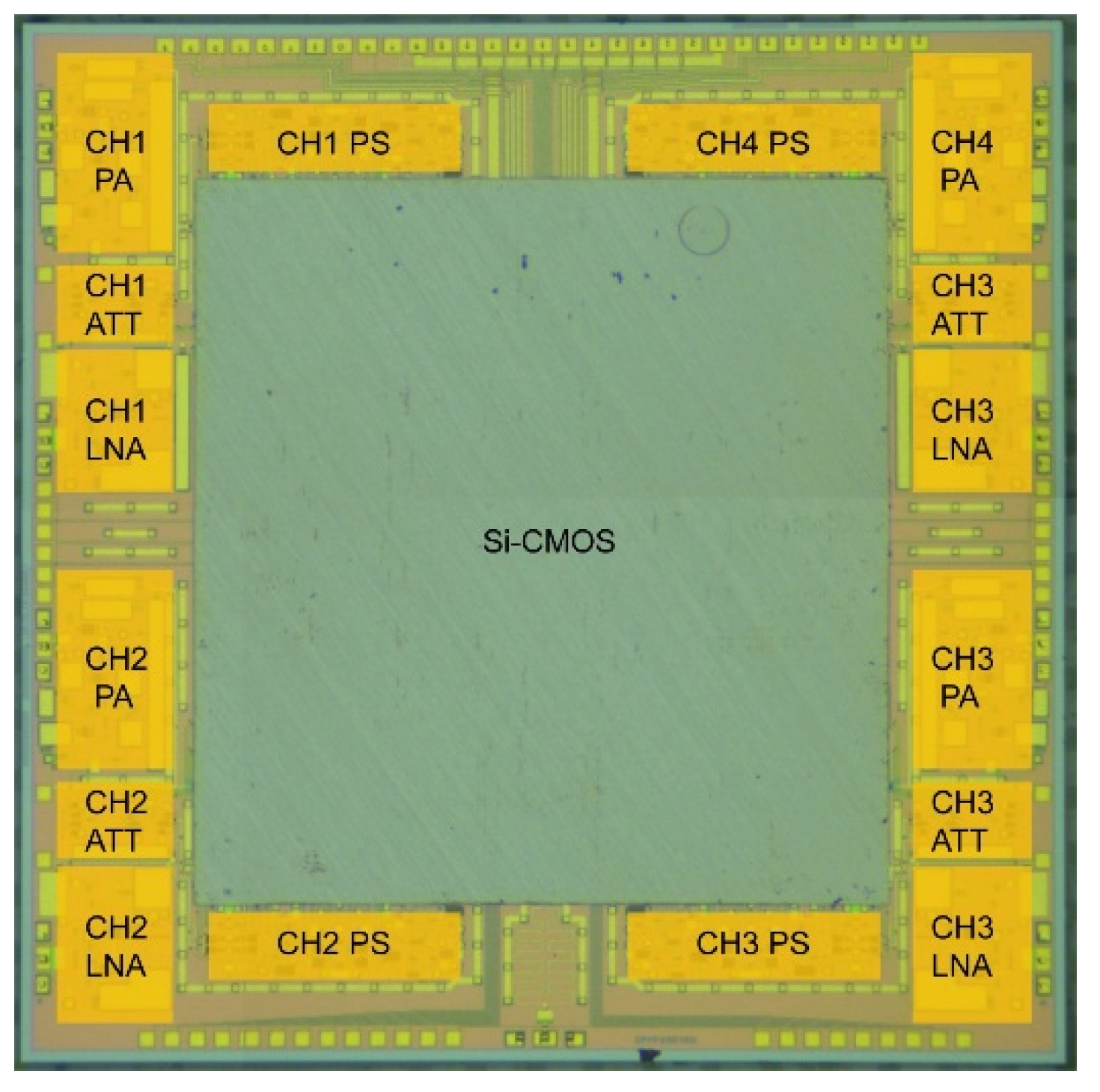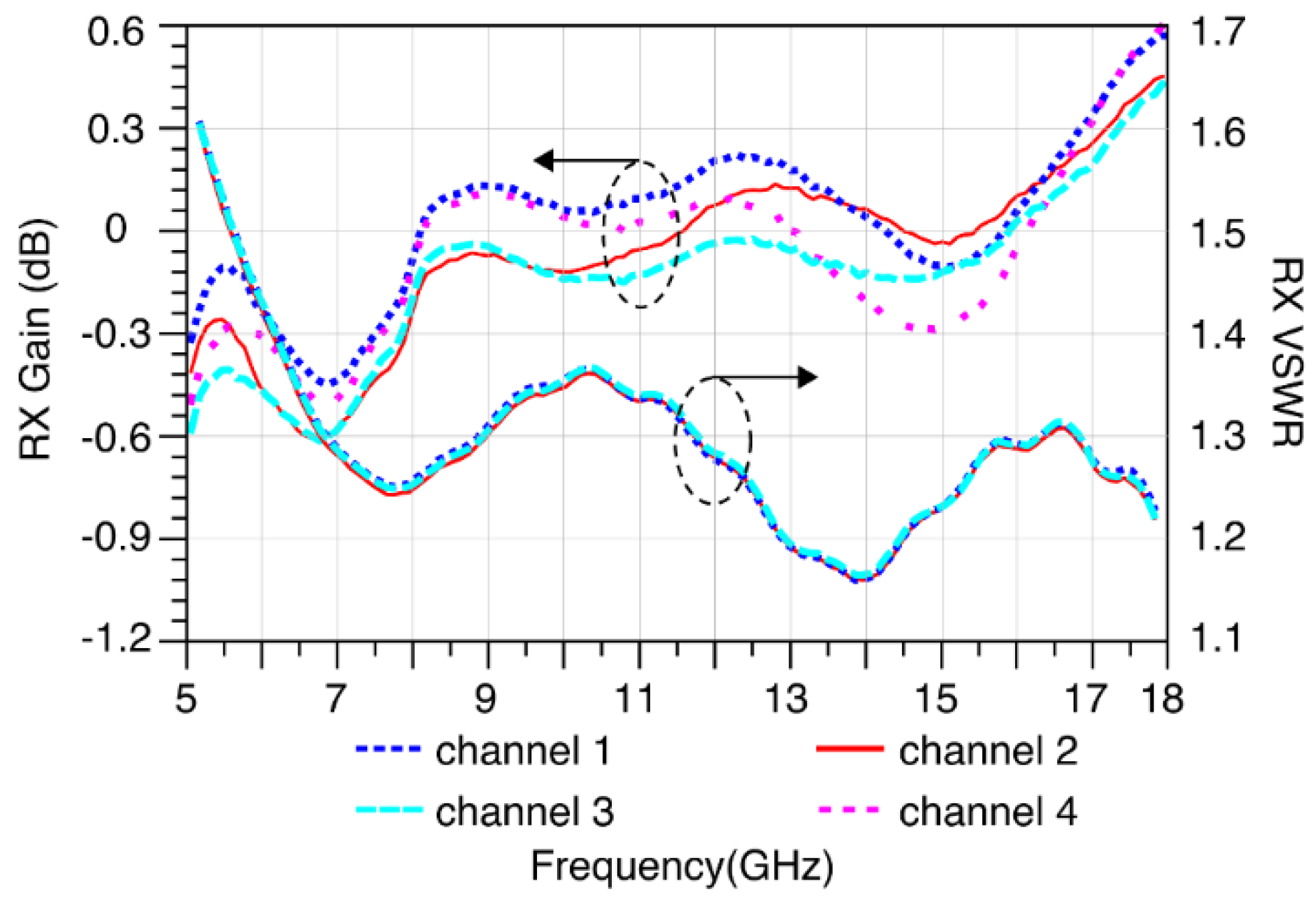1. Introduction
The growing demand for broadband, highly integrated, and compact phased-array transceiver chips has driven significant advancements in Monolithic Microwave-Integrated Circuit (MMIC) technology. Phased-array radar operates by electronically steering the beam through precise control of the phase and amplitude of the signal at each antenna element. This technology enables rapid beam scanning and is widely used in advanced applications such as aerospace, detection systems, and next-generation wireless communication systems. In high-performance phased-array radar systems, element spacing plays a critical role in determining system resolution and beamforming accuracy. To achieve optimal performance, particularly at higher frequencies, the spacing between antenna elements is typically required to be less than half the wavelength. This stringent requirement imposes severe constraints on the size of transmit/receive (T/R) modules, necessitating the development of highly integrated, multifunctional RF chips that both optimize electrical performance and have a compact form, as is demonstrated in [
1,
2].
To address these constraints, RF multifunctional chips have been evolving toward a higher integration density, aiming to achieve precise amplitude and phase control, low noise, and high output power, thereby enabling accurate beamforming in phased-array systems [
3]. However, achieving a broadband operation such as 5–18 GHz across multiple transceiver channels within a compact, highly integrated platform remains a significant technical challenge [
4]. This frequency range is particularly critical, as it encompasses several key radar and communication bands, enabling a single system to support multifunctional capabilities. Moreover, wideband operation enhances system performance by improving resolution, target discrimination, and spectral efficiency. Further, considerable efforts have been devoted to the development of multifunctional transceiver chips for phased-array systems. Early implementations primarily focused on integrating phase and amplitude control functions to enable basic beamforming capabilities [
5,
6]. Subsequent advances incorporated low-noise amplifiers and power amplifiers into the same module, thereby enhancing the chip’s reception sensitivity and ability to transmit power [
4]. To further increase their spatial resolution and array scalability, several works have explored multi-channel integration, typically of up to two or four RF channels [
7,
8].
Recently, phased-array transceiver architectures have relied on III-V compound semiconductors, such as GaAs [
4,
9], GaN [
10], and InP [
11], due to their superior power handling, low loss, and high-frequency performance. Despite these advantages, such implementations often suffer from large form factors and limited integration capabilities, as additional packaging and interconnects are required to interface them with digital control circuits [
12]. In contrast, SiGe BiCMOS- and CMOS [
13,
14]-based RF solutions have gained traction in recent years, offering lower costs, a higher integration density, and compatibility with digital beamforming architectures. Despite these advantages, CMOS-based RF implementations remain inferior in terms of their noise figure (NF), working frequency, and power handling when compared to their III-V counterparts [
15,
16].
Table 1 summarizes the key performance parameters of several commonly used semiconductor technologies for RF transceivers, including their frequency range, integration scale, and noise characteristics [
16].
To overcome these challenges, 3D heterogeneous integration [
17,
18,
19,
20] has emerged as a promising solution for achieving compact, high-performance RF front-end designs. By vertically stacking and integrating high-performance GaAs RF circuits with Si-CMOS-based control circuits, this approach enables the realization of miniaturized, multifunctional T/R modules. Beyond front-end integration, heterogeneous integration extends to the back-end and packaging layers. Advanced packaging technologies, such as wafer-level packaging (WLP) and system-in-package (SiP) configurations, facilitate the embedding of passive components—such as resistors, capacitors, and inductors—directly into the packaging substrate. This integration reduces parasitic effects, enhances signal integrity, and contributes to the miniaturization of RF systems. For instance, low-temperature co-fired ceramics (LTCC) technology allows for the incorporation of passive elements within a ceramic substrate, offering improved RF performance and compactness [
21]. In the proposed design of the phased-array transceivers, heterogeneous 3D integration effectively combines the high-frequency performance of GaAs with the high-density integration and cost-effectiveness of Si-CMOS, thereby surpassing the limitations of conventional single-process integrated circuits. Further, recent advances in magnetic film engineering and passive component integration—such as Permalloy rings and CoZrTaB thin films—have significantly improved the inductance and quality factors of on-chip RF components [
22,
23,
24]. These techniques support the ongoing movement toward compact, high-frequency multifunctional transceiver designs.
This paper presents a heterogeneously integrated 5–18 GHz four-channel RF multifunction chip, which combines a high-performance GaAs front-end RF with a Si-CMOS digital control circuit. The RF and digital chips are heterogeneously integrated using flip-chip and fan-in technology, resulting in a highly compact chip size of 6.2 × 6.2 × 0.33 mm3. The RF chip, fabricated using a 0.15 μm GaAs pHEMT process, enables four-channel transmission and reception with its 6-bit digital phase shifters, 6-bit digital attenuators, low-noise amplifiers (LNAs), power amplifiers (PAs), single-pole double-throw (SPDT) switches, and power division functions. High-isolation techniques, including a ground-connected shielding layer in the fan-in process and on-chip shielding cavities, are employed to enhance multi-channel isolation and reduce crosstalk, achieving an isolation level exceeding 41 dB between adjacent RF channels. The measurement results show that the maximum amplitude and phase RMS errors are, respectively, less than 0.5 dB and 3.3°. And the multifunction chip achieves a reception gain of 0 dB with ±0.6 dB flatness, an NF of below 11 dB, and transmit gain of more than 10 dB, with a VSWR of below 1.6 over the entire 5–18 GHz frequency band.
The remainder of this paper is structured as follows:
Section 2 describes the chip’s architecture and the integration approach used.
Section 3 details the RF circuit’s analysis and design, including its amplifiers, phase shifters, and attenuators.
Section 4 introduces the high-isolation techniques used to minimize interference.
Section 5 presents the measured performance results. A conclusion is given in
Section 6.
2. Multifunction Chip Architecture
The proposed multifunctional RF chip employs 3D heterogeneous integration to achieve a compact, high-performance solution for phased-array applications. As shown in
Figure 1, the proposed design consists of two primary components. The RF chip is fabricated using a 0.15 μm GaAs pHEMT process; this chip enables a high-performance microwave amplitude and phase control across four channels. The digital chip is implemented using a Si-CMOS process; this chip provides multi-channel serial-to-parallel conversion, power management, electrostatic discharge (ESD) protection, and power-on reset functions. The fan-in process redistributes the I/O contact points of the CMOS chip, allowing seamless integration with the GaAs chip.
The integration of the GaAs RF chip and the Si-CMOS digital chip is realized through 3D heterogeneous stacking. The Si-CMOS chip is flipped and precisely aligned with the GaAs RF chip using a high-precision flip-chip bonder. A stack of gold bumps is utilized for both electrical and mechanical interconnections. Hot pressing and ultrasonic welding are used to create low-resistance electrical interconnects, minimizing contact resistance and interfacial defects. By integrating the GaAs front-end RF and Si-CMOS digital control logic into a single monolithic system, this heterogeneous 3D architecture optimizes the system’s performance, reduces its footprint, and improves its scalability.
As illustrated in
Figure 2, the RF circuit is structured with four independent transmission (TX) and reception (RX) channels, each containing a digitally controlled phase shifter, digitally controlled attenuator, low-noise amplifier, power amplifier, and SPDT switches.
4. High-Isolation Design
High-performance phased-array systems require compact, broadband, and multi-channel RF chips. The increasing demand for such devices has driven significant advancements in the integration of RF multifunctional chips. As a result, chip dimensions continue to shrink, making high isolation between different channels and isolation between adjacent functional circuits increasingly important.
To achieve seamless integration, a flip-chip bonding and fan-in process is employed to connect the GaAs-based RF chip with the Si-CMOS digital control chip, as shown in
Figure 1b. A flow diagram of the heterogeneous 3D integration process, including fan-in redistribution, gold bumping, and flip-chip bonding is provided in
Figure 13. Stacked gold bumps with a diameter of 55 μm are vertically planted on the chip pads, ensuring both mechanical support and reliable electrical interconnection. The vertical distance between the GaAs and Si-CMOS chips is approximately 50 μm, which necessitates the careful use of interference mitigation strategies to minimize unwanted coupling between the digital and RF circuits.
4.1. Challenges in Achieving High Isolation Between RF and Digital Chips
The flip-chip bonding process of the Si-CMOS chip is employed in heterogeneous 3D integration to enable its high electrical performance by providing a shorter interconnect path between the digital control chip and the RF multifunctional chip. However, heterogeneous 3D integration creates a complex electromagnetic environment, where multiple signals—microwave signals, digital control signals, and power supply noise—coexist. When Si-CMOS chips are flipped and mounted on the GaAs chips, it will inevitably alter the electromagnetic field environment of the active GaAs devices, thereby affecting the parasitic parameters of the active devices and signal transmission.
The original microstrip line transmission mode on the GaAs surface will change to a non-uniform suspended stripline mode. At this time, the impedance of the original matching point will change, resulting in circuit mismatch and a generally larger transmission loss. Further, in the proposed design, an additional metal shielding layer connected to the ground is introduced during the fan-in process. This shielding layer isolates the digital signal on the Si-CMOS chip from the RF signal on the GaAs chip while satisfying the pressure point interconnection between the Si chip and the GaAs chip, thereby achieving a design with good electromagnetic compatibility.
4.2. Design for High Isolation Between RF and Digital Chips
The proposed four-channel RF chip has a compact footprint of 6.2 × 6.2 mm2 (0.2 × 0.2 λ2 at 10 GHz). Due to its high integration density, the mutual coupling effects between different channels and between various functional circuits are significant. These coupling effects will interfere with the RF signal’s integrity and the DC voltage’s stability. The integrated design of the Si and GaAs chips is required to suppress crosstalk and preserve RF performance.
In the proposed design, shielding cavities are introduced to improve the isolation between different channels and between various functional circuits.
Figure 14a shows a diagram of the traditional four-channel multifunction chip, while
Figure 14b presents the proposed four-channel multifunction chip, which incorporates shielding cavities.
Figure 14c depicts an individual channel, where sub-circuits are denoted by orange boxes and shielding cavities are outlined with red dashed lines. These shielding cavities are constructed using stacked bumps interconnected by microstrip lines and ground layers within the RF and digital chips, effectively reducing electromagnetic coupling.
To characterize the isolation enhancement of the shielding cavities, the effect of two parallel microstrip lines with a gap of 235 μm was calculated using electromagnetic simulation software. The simulated coupling coefficient, with and without the shielding cavities, is shown in
Figure 15a, where the blue dashed line represents the case without shielding cavities and the red solid line represents the case with shielding cavities. It can be seen that the isolation has been improved by about 16 dB. Further, the measured coupling coefficient between two adjacent RF channels on the multifunction chip is shown in
Figure 15b, which demonstrates that the isolation exceeds 41 dB, confirming the effectiveness of the proposed shielding cavity design in mitigating inter-channel interference.
The improvement in isolation not only improves channel-to-channel isolation but also effectively separates functional sub-circuits within individual channels, thereby enhancing overall chip performance. This technical route solves the electromagnetic interference problem between adjacent channels and adjacent sub-circuits, ensures the integrity of RF signals within each sub-circuit, and effectively weakens the mutual coupling between sub-circuits and channels. From a fabrication perspective, the implementation of shielding cavities poses several challenges. These include the need for high bump uniformity, precise alignment between the RF and digital dies during the flip-chip bonding process, and careful impedance control to minimize any undesired signal reflections. Nonetheless, the proposed structure enables effective electromagnetic isolation within a compact heterogeneous 3D integration framework, without increasing the overall footprint of the chip.
5. Measurement Results
The designed four-channel multifunction chip was fabricated through a 0.15 μm GaAs pHEMT process. A picture of the heterogeneous integrated chip is shown in
Figure 16, with the RF chip being 6.2 × 6.2 mm
2. The profile height of the heterogeneous integrated chip is 0.33 mm. The measured results of 64 states of phase shifting are given in
Figure 6,
Figure 7 and
Figure 8. And the measured results of 64 states of attenuation are given in
Figure 10,
Figure 11 and
Figure 12. In summary, the RMS error of the phase shift is less than 3°, and the parasitic amplitude variation in the phase shifter is less than 0.8 dB. The RMS error of the attenuation is less than 0.5 dB, and the corresponding phase variations are within ±8°. The measurement results for the transmission and reception channels are shown in
Figure 17,
Figure 18 and
Figure 19. All measurement results are consistent with the design’s goals.
Figure 17 depicts the measured small-signal gain and VSWR of the four reception channels. It can be observed that the typical value of the receiving gains is greater than 0 dB with a good gain flatness of ±0.6 dB. The VSWR of the reception channels are lower than 1.6.
Figure 18 depicts the measured noise figure (NF) of one reception channel, which shows that the NF is lower than 11 dB in the working frequency band. The reception channel exhibits a NF below 11 dB, which is relatively high for sensitive applications such as radar or communication systems, where a lower NF is often desired. It is important to clarify that in practical phased-array radar and communication systems, the proposed multifunctional RF chip would not typically be deployed as the first stage of the front-end receiver. Instead, it is preceded by an external LNA and limiter, which provide front-end protection and establish the dominant contribution to the overall system’s noise figure. Hence, the noise contribution of the multifunctional chip is significantly suppressed across the whole receiving chain according to the formula used for the cascaded noise figure.
Figure 19 depicts the measured small-signal gains and VSWR of the transmission channels. It can be seen that in their transmitting state, the typical value of the transmission gain is greater than 10 dB, with a VSWR lower than 1.6.
Figure 20 depicts the measured output power of the transmission channel under different ambient temperatures. The proposed chip demonstrates a 1 dB compression point (P1dB) exceeding 19 dBm at 25 °C, with the output power remaining above 20 dBm at –55 °C and above 18 dBm at 85 °C. These results confirm that the transmitter maintains a stable performance and linearity across a wide temperature range, demonstrating a robustness suitable for various environmental conditions.
To further demonstrate the advantages of the proposed design,
Table 2 presents its comparison with representative state-of-the-art multifunctional transceiver chips. Key parameters such as process technology, operating frequency range, the resolution of the phase shifter and attenuator, RMS phase and amplitude errors, the number of integrated channels, digital chip integration capability, and chip area are evaluated. As shown, some existing works either focus on narrowband implementations, offer fewer channels, or lack digital control integration. In contrast, the proposed chip achieves four-channel operation across a wide frequency band (5–18 GHz), with 6-bit resolution in both its phase and amplitude control, and achieves competitive accuracy (RMS phase error <3°, RMS attenuation error <0.5 dB) while incorporating a Si-CMOS digital control chip into its system through heterogeneous 3D integration. This integration significantly enhances the system’s compactness and scalability.
6. Conclusions
This paper presents a 5–18 GHz four-channel multifunctional RF chip based on the heterogeneous 3D integration of GaAs and Si-CMOS technologies. The proposed chip can handle broadband phase shifting, amplitude control, power amplification, and switching functions within a compact footprint of 6.2 × 6.2 × 0.33 mm3, making it well suited to advanced phased-array radar systems.
To address the challenges with high integration, this work employs flip-chip bonding and stacked gold bumps, enabling a compact 3D integration of the RF and digital chips. A fan-in redistribution process is implemented to ensure high-density interconnections with minimal parasitic effects. To further improve multi-channel isolation, a shielding layer is added in the fan-in redistribution process, reducing the interference between the RF and digital circuits. At the same time, on-chip shielding cavities significantly improve the isolation between adjacent channels and adjacent sub-circuits.
The measured results of the chip’s performance are consistent with the design targets. Within a working frequency band of 5–18 GHz, the receiving gains are greater than 0 dB with a good gain flatness of ±0.6 dB and a NF lower than 11 dB. The VSWR of the reception channels is lower than 1.6. The small-signal gains of the transmission channels are greater than 10 dB with a VSWR lower than 1.6. The 64-state phase shift root mean square (RMS) error is less than 3°, and the additional amplitude variation in the phase shifter is less than 0.8 dB; the 64-state attenuation RMS error is less than 0.5 dB, and the parasitic amplitude modulation RMS is less than 7°. The isolation between the RF channels is above 41 dB. These results validate the feasibility and effectiveness of the proposed heterogeneous 3D integration approach to creating compact, high-performance phased-array transceivers.
